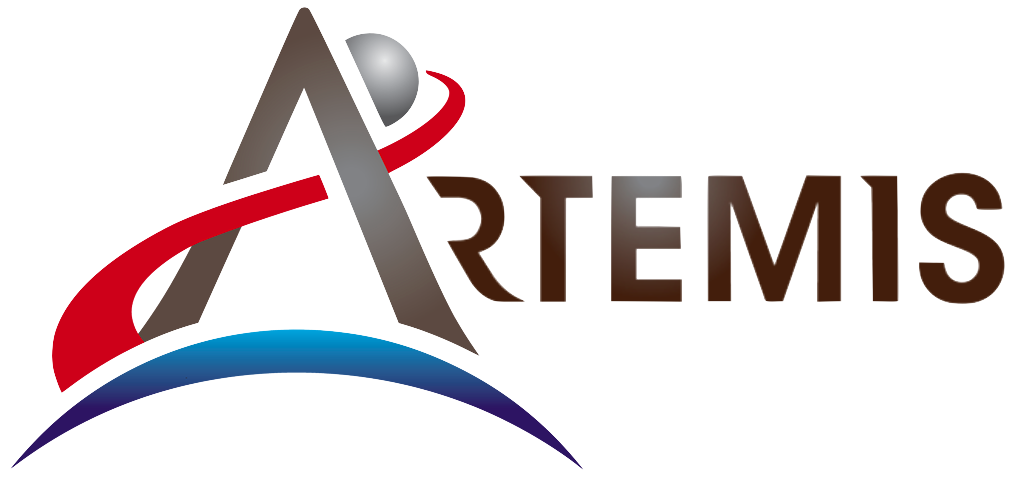BACK TO THE MOON, BUT TO STAY!
"And, as we leave the Moon at Taurus-Littrow, we leave as we came
and, God willing, as we shall return, with peace and hope for all
mankind". Those were the last words spoken by Apollo 17's mission
commander, Eugene Cernan, on the surface of the Moon on December
14th, 1972. Half a century later, NASA will be returning to the
Moon for the first time with humans since Apollo 17, with a
program named Artemis. However, this time, it will be
different. During Apollo, the astronauts were all men, and their
stay on the lunar surface was not longer than about 3
days. Artemis, on the contrary, will also bring women to the Moon,
and the permanence there is expected to become continous in the
long term. We are going back to the Moon to stay on the Moon. This
will be a fundamental step forward if one wants to venture into
manned deep space exploration: the next major goal is to set foot
on Martian soil. And for this, the Moon -and Artemis- is an
essential stepping stone.
A key element in any sustainable human precense on a world
different from ours is the availability of liquid water. Water is
made out of oxygen and hydrogen, elements that can be used as
fuel, as well as in the production of electricity, breathable air
and drinkable water. These obviously are very necessary resources
to propel spacecrafts and support life in environments specially
built for human development outside the Earth. The first direct
evidence of the precense of water vapor near the lunar surface was
obtained by one of the experiments of the Apollo 14 mission, in
1971. Although the possibility of finding ice in the lunar poles
was first suggested in 1961, its robust confirmation remained
elusive for decades. Since 2009, observational evidence that
indicates the existence of water ice in the poles of the Moon has
been accumulating. Due to the inclination of its rotation axis,
the Moon's poles have areas that are in permanent darkness, being
ideal, cold places to keep water ice. These areas are also thought
to work as cold traps where water vapour can be
collected. Therefore, the lunar poles are prime targets for the
next areas to be explored by future missions in Artemis.
To get there, NASA is developing its next generation of space
transportation system. One that will not only bring people back to
the Moon, but that will enable human transportation into deeper
space, i.e. Mars. This new powerful propulsion system is know as
the Space Lauch System (SLS). The SLS will be the most powerful
rocket to fly into space since the Saturn V (the most poweful one
so far in terms of total impulse). It uses very well proven
components from the Space Shuttle Program, such as the shuttle
engines, the external fuel tank, and the solid rocket
busters. However, in contrast to the Space Shuttle, it has an
essential difference: it goes back to the design of the
Saturn-family rockets or even that of the Russian rockets, where
the spacecraft is located on top of the whole propulsion assembly
(fuel tanks and rocket motors). This design turns out to be safer
than the one used to distribute the components of the Space
Shuttle. By being the spacecraft on top, it stays out of direct
reach by any debris or faulty elements associated with the
propulsion elements. In the case of the Space Shuttle, the Orbiter
Vehicle was at the same level of the solid rocket busters and the
main fuel tank, where design issues with them ultimately led to
the tragic loss of two crews.
Another element that goes back to the classical design is the
spacecraft itself. Named Orion, the capsule is a
truncated-cone-shaped structure, considerably larger than that
used in the Apollo program. It is capable of transporting from 2
to 6 astronauts, and also has a service module component, like
Apollo. The Orion spacecraft already had its first test flight in
December 2014. That mission provided very valuable data to improve
its design and systems prior to the first crewed test
flight. Similar to the Saturn V configuration, the Orion
spacecraft, mounted on the SLS, has too a launch scape tower that
should take the capsule and crew to safety in the event of a
serious malfunction during lift-off. In Artemis, Orion will
transport astronauts to lunar orbit, where it will eventually dock
to a novel component of the lunar trip design, a structure flying
around the Moon that will support trips from lunar orbit down to
the lunar surface an back: the so-called Gateway. This space
station in lunar orbit, when in place, will allow astronauts, for
example, to relax and get prepared for their Moon mission or go
back to Earth. It will receive both the Orion spacecraft and the
actual lunar lander. Like with Apollo, the latter is a crucial
element that will make the whole objective of going back to the
surface of the Moon possible. The landing on the Moon and the
actual EVA on its surface is expected to take place near to or on
areas in darkness, those in the perpetual night of the likely
landing sites on one of the Moon's poles.
Once on the lunar surface, the astronauts will need to perform a
number of tasks, working hard to establish a permanent and
sustainable settlement for humans on the Moon. This include
building appropriate habitats (a lunar base) and developing the
necessary technology that will allow people to even use the Moon
as a plataform to study the universe and travel to deeper
space. For all that, the availability of the most suitable
extravehicular mobility unit, a.k.a. the space suit, is
crucial. During Apollo, astronauts were equiped with the most
advanced suit available at that time. However, it had limitations
in terms of comfort, flexibility and autonomy that duplicating
something like it turns out to be inadequate for Artemis. That is
why the Exploration Extravehicular Mobility Unit (xEMU) has been
developed. It is built to fit exactly the anatomy of the user, and
has a significantly improved flexibility, among other features. It
also has parts that can be replaced if needed. All in all, the
xEMU is designed for an extraordinarily improved performance
necessary for the demanding tasks of Artemis on the Moon. But that
is not all, as the xEMU will be the basis for the space suite that
astronauts should wear on Mars.
In 2017, the US Government gave a directive to NASA to focus its
manned space program on going back to the Moon by 2024. By means
of its Commercial Crew Program, NASA is working closely with the
private industry (e.g. SpaceX and Boeing) to maintain a rutinary
access to Low Earth Orbit and the International Space Station. By
letting private companies to take care of that, NASA is able to
concentrate on developing the SLS, Orion, and the whole Artemis
endeavor to go back to the Moon by the above deadline, and then on
to Mars by 2030. The 2017 class incorporated new people to NASA's
list of currently
active astronauts eligible for flight asignments, men and
women who will be traveling to the Moon with Artemis. On July
20th, 1969, Neil Armstrong became the first man to walk on the
moon. Now, the big question is: who will be the
first woman to step on another world?
— August 2020.

The following is a collection of selected information on NASA's Project Artemis:

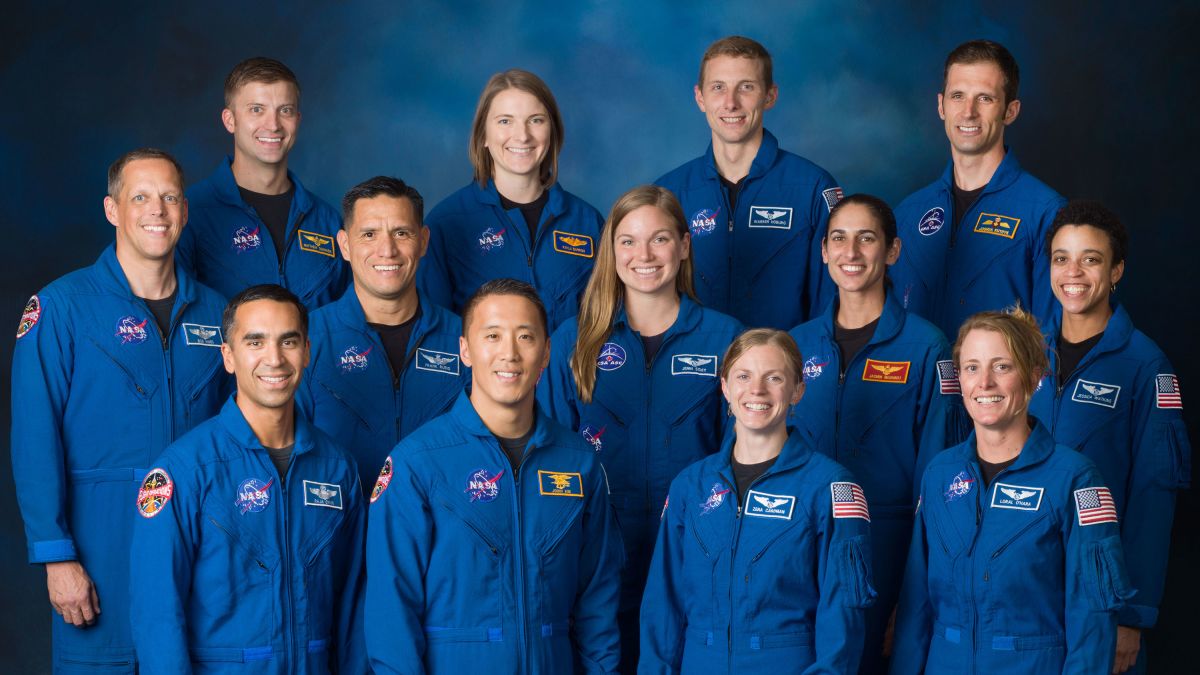 NASA’s astronauts with eyes on Artemis missions. The 2017 class,
the first one in the Artemis generation, includes (top row)
Matthew Dominick of NASA, Kayla Barron of NASA, Warren Hoburg of
NASA, and Joshua Kutryk of CSA, (middle row) Bob Hines of NASA,
Frank Rubio of NASA, Jennifer Sidey-Gibbons of CSA, Jasmin
Moghbeli of NASA, and Jessica Watkins of NASA, (bottom row) Raja
Chari of NASA, Jonny Kim of NASA, Zena Cardman of NASA, and
Loral O’Hara of NASA. Credit: NASA.
NASA’s astronauts with eyes on Artemis missions. The 2017 class,
the first one in the Artemis generation, includes (top row)
Matthew Dominick of NASA, Kayla Barron of NASA, Warren Hoburg of
NASA, and Joshua Kutryk of CSA, (middle row) Bob Hines of NASA,
Frank Rubio of NASA, Jennifer Sidey-Gibbons of CSA, Jasmin
Moghbeli of NASA, and Jessica Watkins of NASA, (bottom row) Raja
Chari of NASA, Jonny Kim of NASA, Zena Cardman of NASA, and
Loral O’Hara of NASA. Credit: NASA.
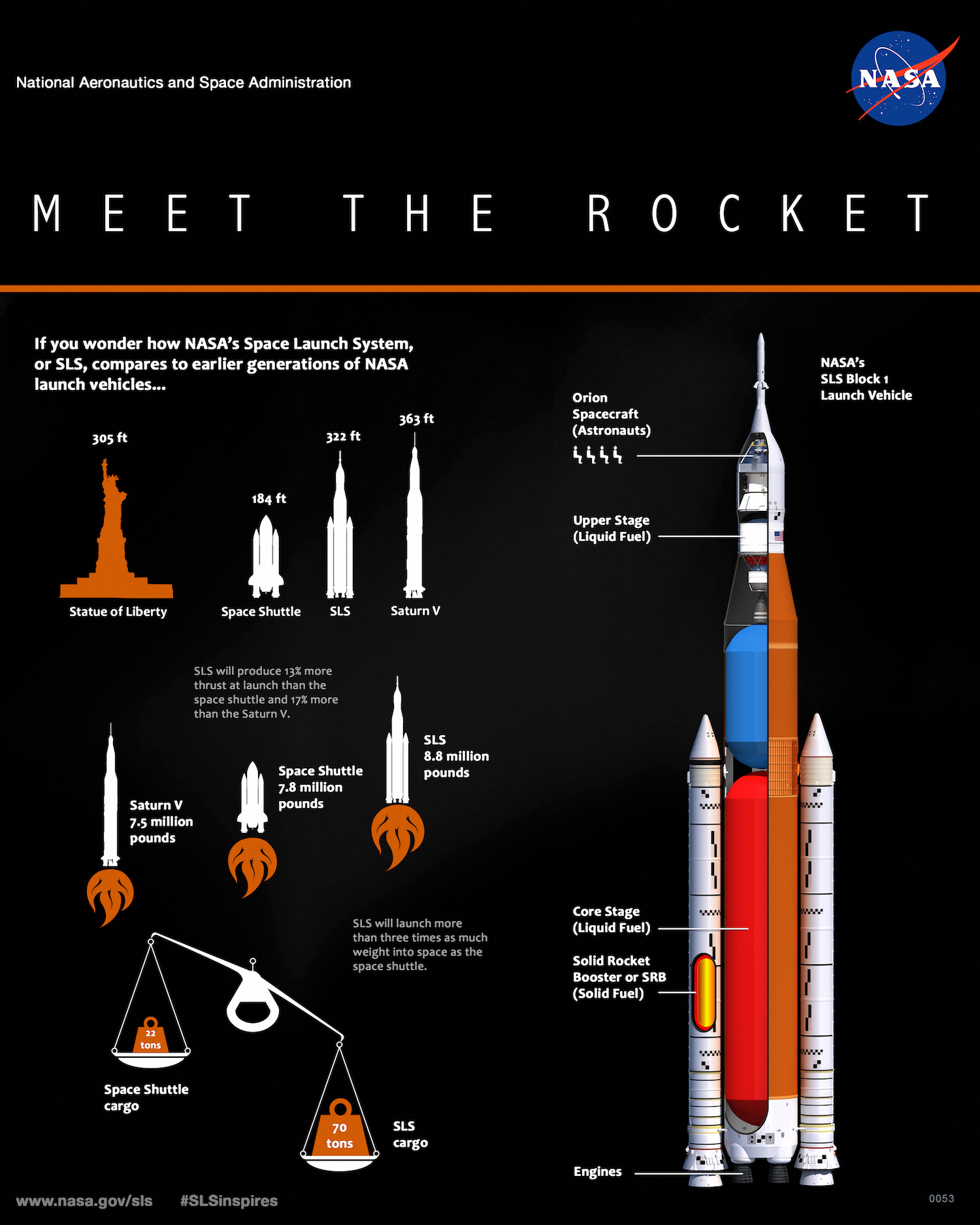 The Space Launch System, NASA's next generation launch vehicle
to transport humans and cargo to deep space (i.e. the Moon,
Mars, and beyond). When operational, it will be the most
powerful rocket ever built. Its design takes well proven
componentes from the Space Shuttle Program, and the general
lay-out of rockets such as the Saturn V and Soyuz. Credit:
NASA.
The Space Launch System, NASA's next generation launch vehicle
to transport humans and cargo to deep space (i.e. the Moon,
Mars, and beyond). When operational, it will be the most
powerful rocket ever built. Its design takes well proven
componentes from the Space Shuttle Program, and the general
lay-out of rockets such as the Saturn V and Soyuz. Credit:
NASA.
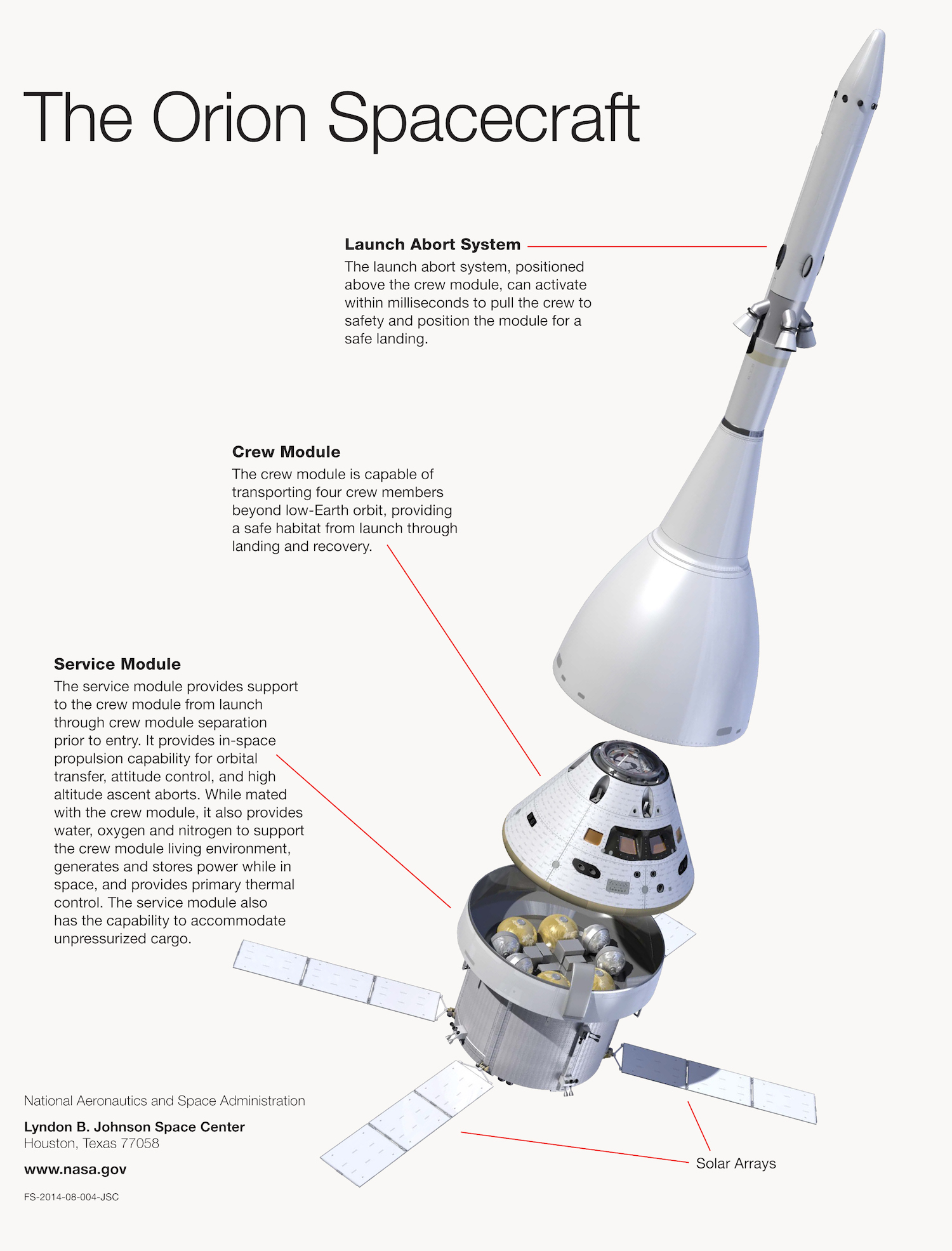 The Orion
Spacecraft is NASA's exploration vehicle that will take humans
back to lunar orbit and evantually to Mars. Its structure follows
that of the Apollo spacecraft, with a crew module and a service
module. Larger than Apollo, it will carry more astronauts, and
will also provide an emergency abort capability, sustain the crew
during the space travel, and provide a safe re-entry from
deep-space return velocities. The whole spacecraft is the result
of an international collaboration between the US (to build the
crew module) and Europe (to build the service module). Credit:
NASA.
The Orion
Spacecraft is NASA's exploration vehicle that will take humans
back to lunar orbit and evantually to Mars. Its structure follows
that of the Apollo spacecraft, with a crew module and a service
module. Larger than Apollo, it will carry more astronauts, and
will also provide an emergency abort capability, sustain the crew
during the space travel, and provide a safe re-entry from
deep-space return velocities. The whole spacecraft is the result
of an international collaboration between the US (to build the
crew module) and Europe (to build the service module). Credit:
NASA.
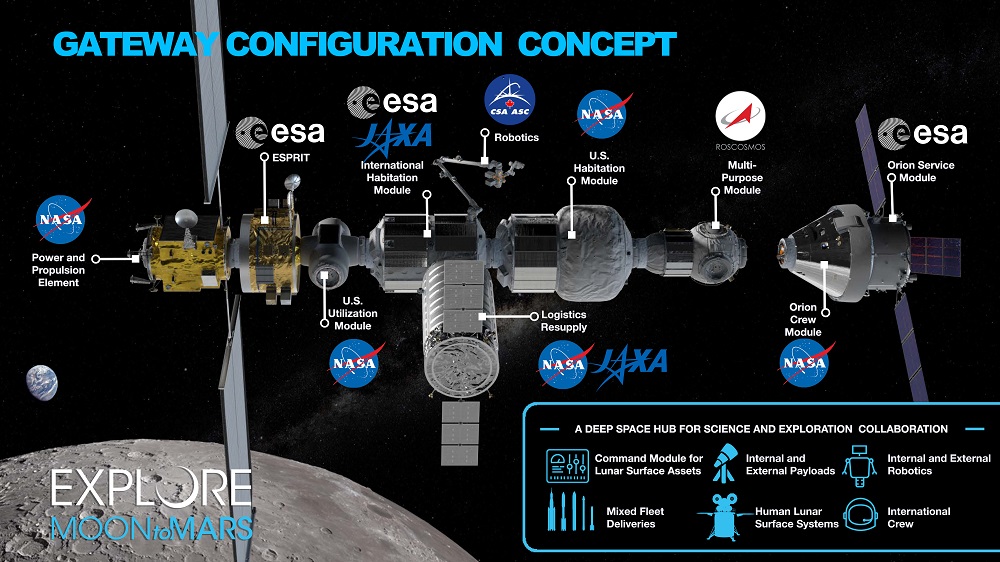 The lunar Gateway represents a novel component of the Artemis
effort: a lunar orbiting space station that will relay crews
from Earth to the Moon (and beyond), and viceversa. In a way similar
to the International Space Station, it is composed by
habitable modules that will allow astronauts to perform all
necessary activities before and after their trip to the lunar
surface. Its construction is another example of multinational
cooperation in space exploration. Credit: NASA.
The lunar Gateway represents a novel component of the Artemis
effort: a lunar orbiting space station that will relay crews
from Earth to the Moon (and beyond), and viceversa. In a way similar
to the International Space Station, it is composed by
habitable modules that will allow astronauts to perform all
necessary activities before and after their trip to the lunar
surface. Its construction is another example of multinational
cooperation in space exploration. Credit: NASA.
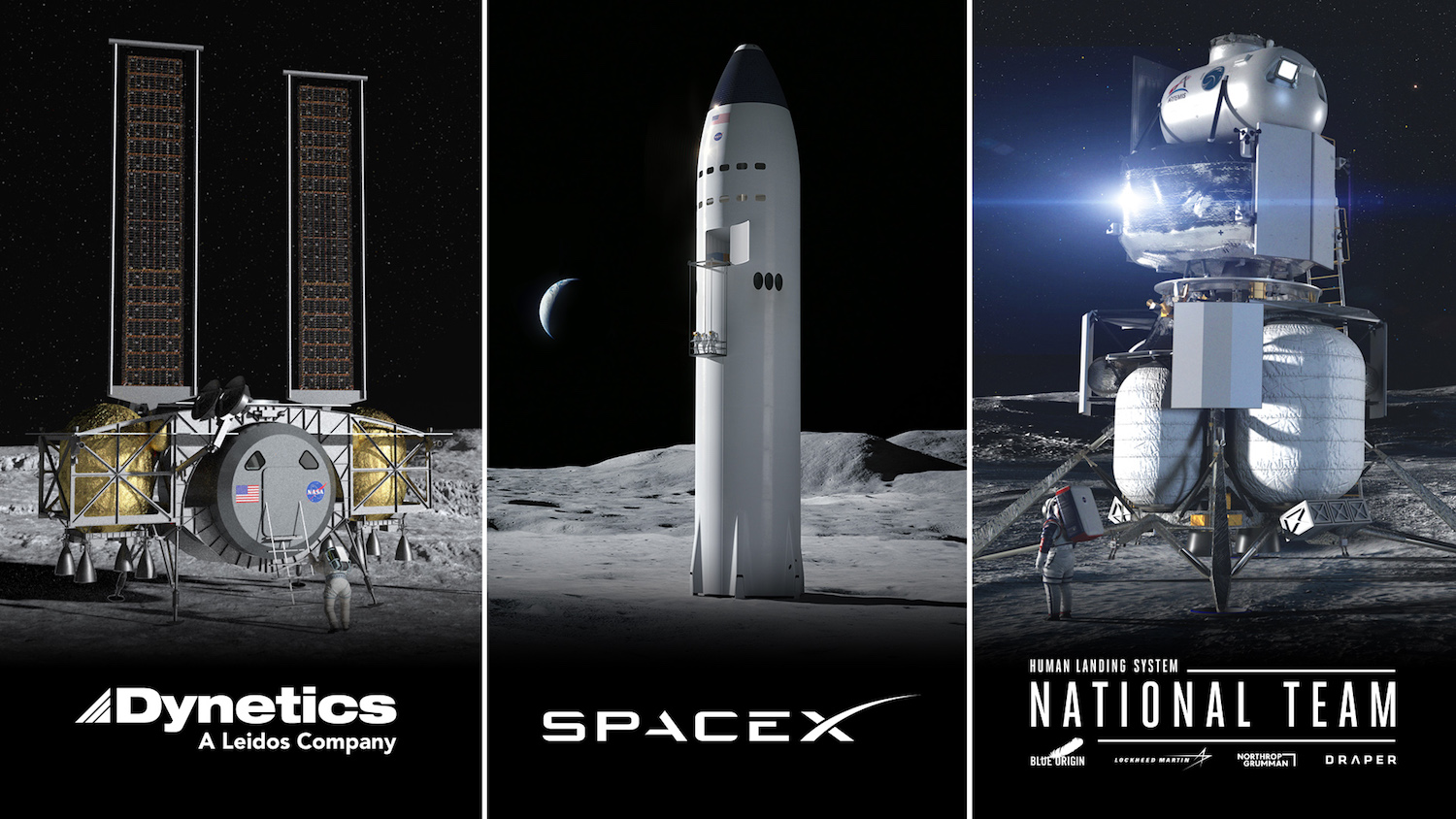 The selected proposals to work on the design and construction of
human landing systems to bring astronauts back to the lunar
surface. Half a century ago, Apollo proved that it was possible
to land humans on the Moon and return them safely to Earth. With
the Artemis program, NASA will go back in a way that reflects
the world today: with government, industry, and international
partners in a global effort to build and test the systems and
components needed for challenging missions to the Moon, Mars and
beyond. In the so-called "National Team", one of the companies
participating is Northrop Grumman, the result of Northrop
acquiring Grumman Aerospace. The latter has a singular history
in lunar exploration: it was responsible for building all the
lunar modules that have ever landed on the Moon's
surface. Credit: NASA.
The selected proposals to work on the design and construction of
human landing systems to bring astronauts back to the lunar
surface. Half a century ago, Apollo proved that it was possible
to land humans on the Moon and return them safely to Earth. With
the Artemis program, NASA will go back in a way that reflects
the world today: with government, industry, and international
partners in a global effort to build and test the systems and
components needed for challenging missions to the Moon, Mars and
beyond. In the so-called "National Team", one of the companies
participating is Northrop Grumman, the result of Northrop
acquiring Grumman Aerospace. The latter has a singular history
in lunar exploration: it was responsible for building all the
lunar modules that have ever landed on the Moon's
surface. Credit: NASA.
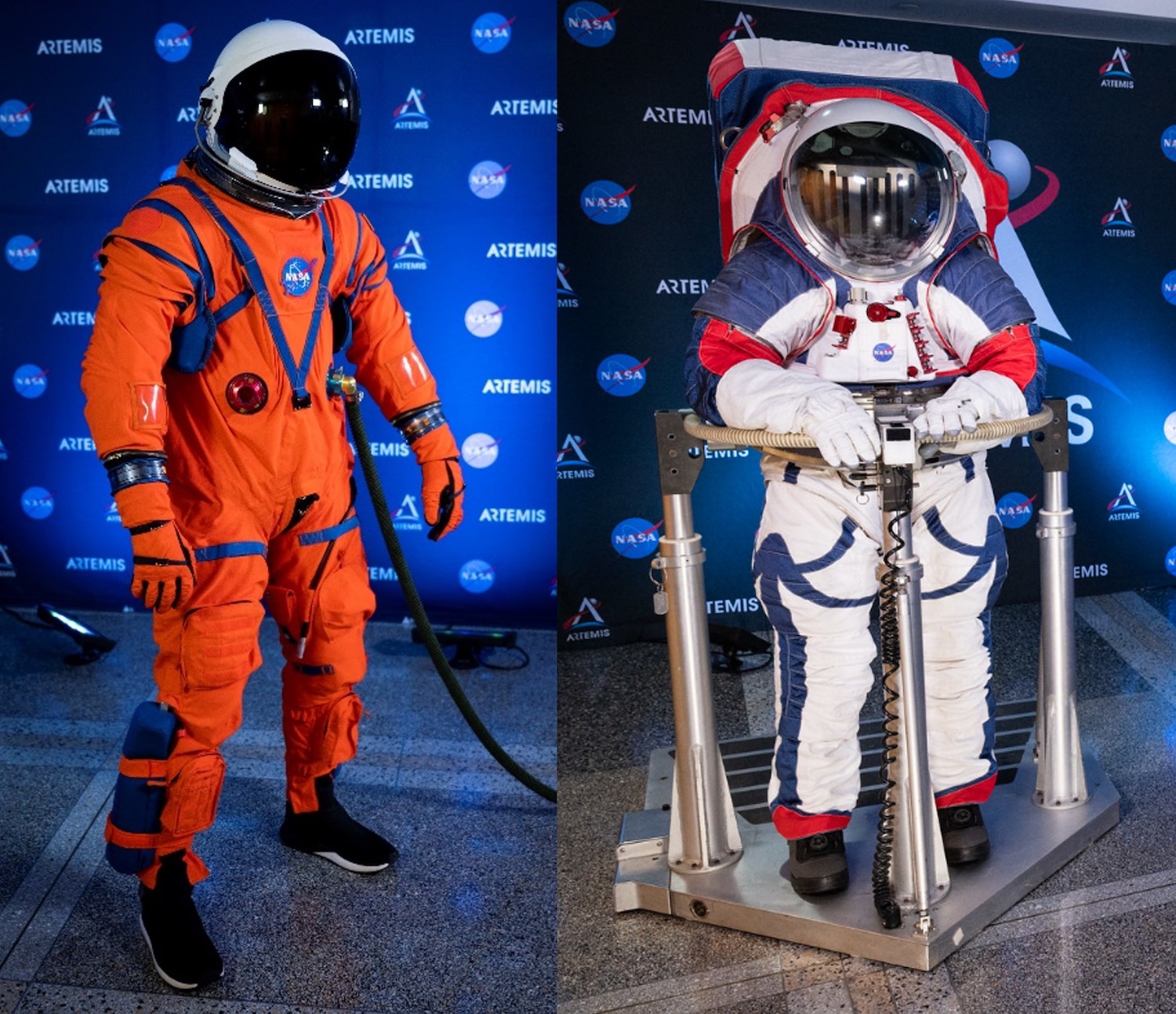 The next generation of space suits for Artemis astronauts. One
for getting to the Moon and back, and one for exploring the
surface of the Moon. Left: The Orion Crew Survival suit. Right:
the Exploration Extravehicular Mobility Unit (xEMU). While the
former, an improved version of the Space Suttle's Launch Entry
Suit, helps the crew to survive in Orion during deep-space
flights, the latter is a significantly improved version of the
famous A7L and A7Lb suits that Apollo astronauts wore during
their EVAs on the Moon. The xEMU offers much more comfort and
flexibility, among other features, to enable extended work on
the lunar surface. Credit: NASA.
The next generation of space suits for Artemis astronauts. One
for getting to the Moon and back, and one for exploring the
surface of the Moon. Left: The Orion Crew Survival suit. Right:
the Exploration Extravehicular Mobility Unit (xEMU). While the
former, an improved version of the Space Suttle's Launch Entry
Suit, helps the crew to survive in Orion during deep-space
flights, the latter is a significantly improved version of the
famous A7L and A7Lb suits that Apollo astronauts wore during
their EVAs on the Moon. The xEMU offers much more comfort and
flexibility, among other features, to enable extended work on
the lunar surface. Credit: NASA.
